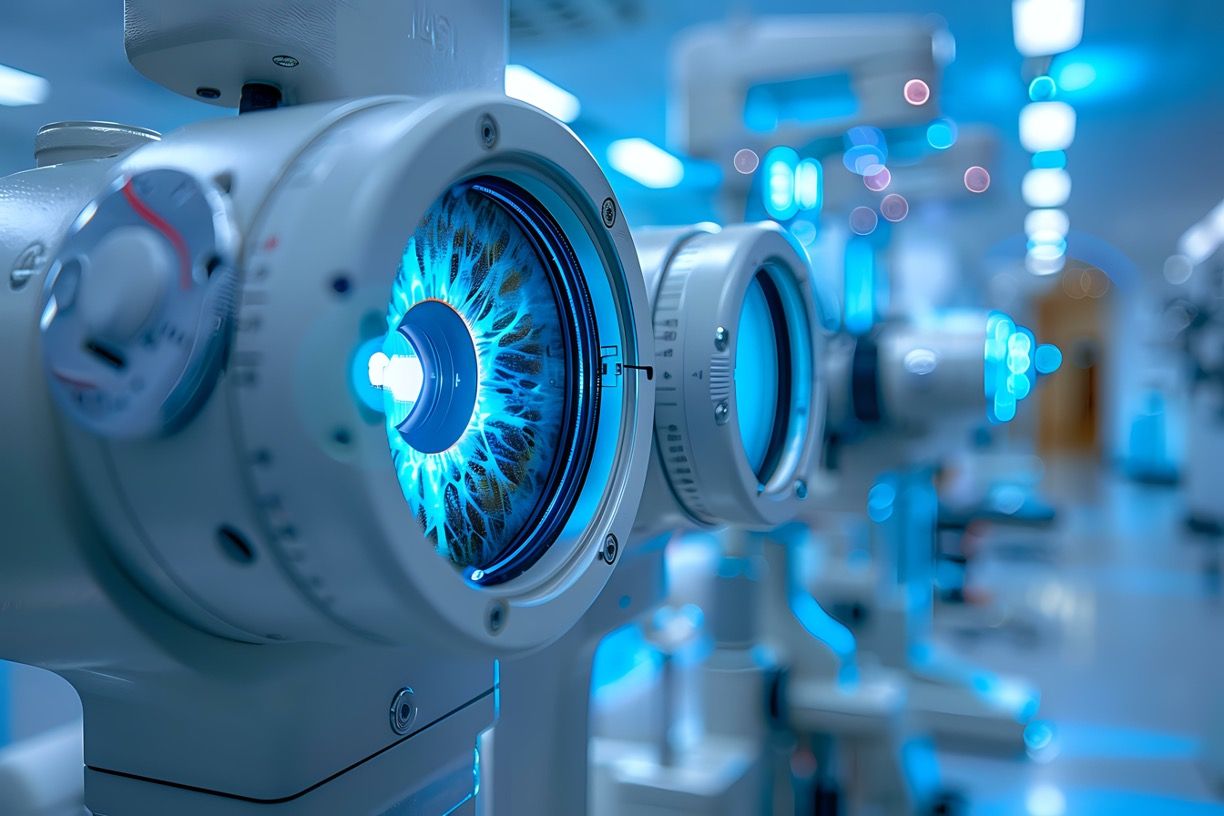News
Article
Smarter Food Processing with AI, Optical Sensors, and Robotics Enhance Quality Control
Author(s):
Researchers at Oregon State University explore how machine learning, optical sensors, and robotics are transforming food quality assessment and processing, improving efficiency and reducing waste.
Futuristic robotic eye and optical sensors (AI generated) © Yuliia-stock.adobe.com

The demand for high-quality food has led to significant advancements in food processing technology (1–3). A recent review by In-Hwan Lee and Luyao Ma, published in Food Innovation and Advances, highlights the integration of machine learning (ML), optical sensors, and robotics to improve food quality assessment (1–3). Conducted at Oregon State University’s College of Agricultural Sciences, the study examines how artificial intelligence (AI) can extract critical data features from optical sensors, enhancing non-destructive food evaluation and streamlining automation (1).
Traditional methods of food quality assessment are often labor-intensive, slow, and destructive. Techniques such as Brix measurement for fruit sweetness, titration for acidity, and manual evaluation of meat marbling are commonly used but have limitations. The study points out that ML combined with optical sensors—such as near-infrared (NIR) spectroscopy, Raman spectroscopy, and hyperspectral imaging (HSI)—can rapidly analyze food quality indicators like color, texture, and chemical composition without damaging the products. This advancement is crucial for maintaining freshness while reducing food waste and processing inefficiencies (1).
The Role of Optical Sensors and Machine Learning
Optical sensors capture valuable information by analyzing light interactions with food. These sensors utilize various techniques, including reflectance, fluorescence, and Raman scattering, to assess key quality indicators. However, interpreting the vast amounts of data generated by these sensors remains a challenge. This is where ML plays a crucial role. By leveraging AI algorithms, researchers can extract meaningful patterns from complex datasets, allowing real-time food quality assessment with high precision (1).
The study underscores how ML enhances classification and regression tasks, helping predict factors such as water content, soluble solids, and color changes in produce and meats. AI-driven models allow industries to minimize human subjectivity in quality assessments while improving accuracy and efficiency (1).
Automation in Food Processing: Robotics and Computer Vision
Beyond quality assessment, AI-powered robotics is revolutionizing food harvesting, sorting, and processing (1–3). Robotics has been used in food industries since the 1970s, but recent advancements in computer vision—a field that merges optical sensors with AI—have significantly expanded their capabilities. Robots can now perform complex tasks, including fruit picking, meat trimming, and seafood grading, with increased precision and consistency (1–3).
Lee and Ma’s review highlights how robotics can reduce human labor demands while improving hygiene and efficiency in food processing plants (1–3). For instance, robotic arms with flexible mechanisms can navigate obstacles, such as leaves in fruit harvesting, improving accuracy and minimizing waste. In meat processing, AI-driven robotic cutting systems can optimize bone removal and meat trimming, preventing unnecessary product loss (1–3).
Challenges and Future Prospects
Despite the promising applications of AI and robotics in food processing, challenges remain. One major limitation is the need for large, standardized datasets to train machine learning models effectively. Currently, only a few publicly available food-specific image databases, such as Food-101 and DeepHS Fruit v2, exist, restricting the scope of AI training (1).
Another challenge is the ‘black-box’ nature of deep learning models, which makes it difficult to interpret their decision-making processes. Future research should focus on developing more explainable AI models that provide transparency in classification and regression results.
Additionally, improving robotic performance is essential for wider adoption. For example, ensuring robots can adapt to various food shapes and sizes while maintaining precision remains a technical hurdle. Enhancing safety measures, such as integrating contact detection sensors, will also be crucial for human-robot collaboration in food processing environments (1).
This study provides a comprehensive review of how AI, optical sensors, and robotics are shaping the future of food quality assessment and automation. These technologies offer rapid, non-destructive food analysis, reducing waste and improving efficiency in food production. However, further advancements in AI model transparency, dataset availability, and robotic adaptability are needed to fully realize their potential. As research continues, these innovations are poised to revolutionize the food industry, ensuring higher quality and safety standards for consumers worldwide (1–3).
References
(1) Lee, I. H.; Ma, L. Integrating Machine Learning, Optical Sensors, and Robotics for Advanced Food Quality Assessment and Food Processing. Food Innov. Adv. 2025, 4 (1), 65−72. DOI: 10.48130/fia-0025-0007
(2) YouTube. How Robots Are Taking Over the Food Industry | Robots Everywhere. Available online: https://www.youtube.com/watch?v=1ALE7wlphsY (accessed March 11, 2025).
(3) YouTube. 3D Smart Sensors for Food Processing Inspection. Available online: https://www.youtube.com/watch?v=gg8vOS22bDk (accessed March 11, 2025).
Newsletter
Get essential updates on the latest spectroscopy technologies, regulatory standards, and best practices—subscribe today to Spectroscopy.




